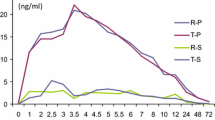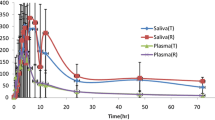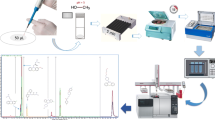Summary
Plasma and salivary caffeine concentrations were measured by gas-liquid chromatography in 6 healthy caffeine-free volunteers following oral administration of 50, 300, 500 and 750 mg caffeine. Caffeine was also given to a single subject intravenously in doses of 300, 500 and 750 mg. Caffeine was rapidly absorbed and was completely available at all doses. The apparent first-order elimination rate constant decreased linearly with dose and was 0.163±0.081 h−1 for 50 mg and 0.098±0.027 h−1 for 750 mg. The total body clearance was unaffected by dose and was 0.98±0.38 ml/min/kg. There was a trend towards increasing apparent volume of distribution with increasing dose. A linear relationship existed between the area under the plasma concentration, time curve and dose and dose-normalised plasma concentration, time plots were superimposable. These findings suggest that caffeine obeys linear pharmacokinetics over the dose range investigated. Despite significant inter-individual differences in pharmacokinetic parameters there was good reproducibility within 5 subjects given 300 mg caffeine orally on 3 occasions. Salivary caffeine levels probably reflect the unbound plasma caffeine concentration and can be used to estimate the pharmacokinetic parameters of the drug. Overall the saliva/plasma concentration ratio was 0.74±0.08 but within subjects some time-dependence of the ratio was found with higher ratios initially (even after intravenous administration) and lower ratios at longer time intervals after the dose. Urinary elimination of caffeine was low and independent of dose: 1.83% of the dose was eliminated unchanged.
Similar content being viewed by others
References
Aldridge A, Parsons WD, Neims AH (1977) Stimulation of caffeine metabolism in the rat by 3-methylcholanthrene. Life Sci 21: 967–974
Aranda JV, Cook CE, Gorman W, Collinge JM, Loughnan PM, Outerbridge EW, Aldridge A, Neims AH (1979) Pharmacokinetic profile of caffeine in the premature new born infant with apnoea. J Pediatr 94: 663–668
Axelrod J, Reichenthal J (1953) The fate of caffeine in man and a method for its estimation in biological material. J Pharmacol Exp Ther 107: 519–523
Burg AW (1975) Effect of caffeine on the human system. Tea Coffee Trade J 147: 40–42
Burg AW, Werner E (1972) Tissue distribution of caffeine and its metabolites in the mouse. Biochem Pharmacol 21: 923–936
Christensen HD, Whitpatt TL, Mamon CV (1980) The assessment of caffeine kinetics for linearity by superposition. Fed Proc. 39: 613
Cook CE, Tallent CR, Amerson EW, Myers MW, Kepler JA, Taylor GF, Christensen HD (1976) Caffeine in plasma and saliva by a radioimmunoassay procedure. J Pharmacol Exp Ther 199: 679–686
Cornish HH, Christman AA (1957) A study of the metabolism of theobromine, theophylline and caffeine in man. J Biol Chem 228: 315–328
Drouillard DD, Vesell ES, Dvorchik BH (1978) Studies on theobromine disposition in normal subjects: Alterations induced by dietary abstention from or exposure to methylxanthines. Clin Pharmacol Ther 23: 296–302
Galeazzi RL, Benet LZ, Sheiner LB (1976) Relationship between the pharmacokinetics and pharmacodynamics of procainamide. Clin Pharmacol Ther 20: 278–289
Gibaldi M, Perrier D (1975) Pharmacokinetics. Marcel Dekker, New York
Goldstein A, Kaizer S, Whitby O (1969) Psychotropic effects of caffeine in man. IV. Quantitative and qualitative differences associated with habituation to coffee. Clin Pharmacol Ther 10: 489–497
Horning MG, Brown L, Nowlin J, Lertratangkoon K, Kellaway P, Zion TE (1977) Use of saliva in therapeutic drug monitoring. Clin Chem 23: 157–164
Jick H, Miettinen OS, Neff RK, Shapiro S, Heinonen OP, Slone D (1973) Coffee and myocardial infarction. N Engl J Med 289: 63–67
Khanna NN, Bada HS, Somani SM (1980) Use of salivary concentrations in the prediction of serum caffeine and theophylline concentrations in premature infants. J Pediatr 96: 494–499
Knop HJ, Kalafusz R, Knols AJF, Van Der Kleijn E (1975) Preliminary report on the saliva/plasma ratio of theophylline after administration of theophylline derivatives in suppositories. Pharm Weekbl 110: 1297–1299
Latini R, Bonati M, Castelli D, Garattini S (1978) Dose-dependent kinetics of caffeine in rats. Toxicol Lett 2: 267–270
Levi L (1967) The effect of coffee on the function of the sympathoadrenomedullary system in man. Acta Med Scand 181: 431–438
MacCornack FA (1977) The effects of coffee drinking on the cardiovascular system: experimental and epidemiological research. Prev Med 6: 104–119
Monks TJ, Caldwell J, Smith RL (1979) Influence of methylxanthine-containing foods on theophylline metabolism and kinetics. Clin Pharmacol Ther 26: 513–524
Nelder JA (1973) Genstat. User's guide no. 1. Inter-University Research Councils Series
Nelder JA, Mead R (1965) A simplex method for function minimisation. Comput J 7: 308–313
Palm PE, Arnold EP, Rachwall PC, Leyczek JC, Teague KW, Kensler CJ (1978) Evaluation of the teratogenic potential of fresh brewed coffee and caffeine in the rat. Toxicol Appl Pharmacol 44: 1–6
Parsons WD, Neims AD (1978) Effect of smoking on caffeine clearance. Clin Pharmacol Ther 24: 40–45
Patwardhan RV, Desmond PV, Johnson RF, Schenker S (1980) Impaired elimination of caffeine by oral contraceptive steroids. J Lab Clin Med 95: 603–608
Robertson D, Frolich JC, Carr RK, Watson JT, Hollifield JW, Shand DG, Oates JA (1978) Effects of caffeine on plasma renin activity, catecholamines and blood pressure. N Engl J Med 298: 181–186
Schmidt G, Schoyerer S (1966) Zum Nachweis von Caffein und seinen Metaboliten im Harn. Dtsch. Z. Ges Gerichtl Med 57: 402–409
Sved S, Hossie RD, McGilveray IJ (1976) The human metabolism of caffeine to theophylline. Res Commun Chem Pathol Pharmacol 13: 185–192
Wagner JG (1976) Linear pharmacokinetic models and vanishing exponential terms: implications in pharmacokinetics. J Pharmacokinet Biopharm 4: 395–425
Weinberger M, Ginchansky E (1977) Dose-dependent kinetics of theophylline disposition in asthmatic children. J Pediatr 91: 820–824
Welch RM, Hsu S-Y, De Angelis RL (1977) Effect of Aroclor 1254, phenobarbital and polycyclic aromatic hydrocarbons on the plasma clearance of caffeine in the rat. Clin Pharmacol Ther 22: 791–798
Author information
Authors and Affiliations
Rights and permissions
About this article
Cite this article
Newton, R., Broughton, L.J., Lind, M.J. et al. Plasma and salivary pharmacokinetics of caffeine in man. Eur J Clin Pharmacol 21, 45–52 (1981). https://doi.org/10.1007/BF00609587
Received:
Accepted:
Issue Date:
DOI: https://doi.org/10.1007/BF00609587




